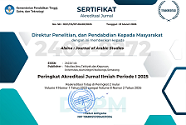Al-Ikhtilāf al-Naḥwī fI al-Lahjah al-ʿĀmmīyah al-Sūdānīyah: Dirāsah Waṣfīyah min Khilāl al-Amthāl al-Shaʿbīyah
DOI:
https://doi.org/10.21580/alsina.3.2.8812Keywords:
Colloquial, dialect, proverb, Sudan, syntaxAbstract
This research aims to clarify the positions and causes of the grammatical difference between the Sudanese dialect and the classical Arabic language by applying to popular proverbs. His approach is descriptive, and one of the most important results is that the Sudanese dialect is one of the largest Arabic dialects currently spoken in the Sudan and in its neighbouring countries. The Sudanese dialect tends to soften the last words in order to mitigate. The connection of mawṣūl (ال) is verbal or nominal sentence or jar-majrūr, which does not adhere to explicit status, and removes the much-returned conscience. The verb (كان) used as a tool of condition in many places. The majrūr nouns is often read as marfūʿ or manṣūb. The double (muthanná) and plural (jamaʿ mudhakkar sālim) read with yā' sign in all positions.
Downloads
References
’Abdin, ’Abd al-Magid, Fawzi F Gadallah, and G N Sanderson. “Some General Aspects of the Arabisation of the Sudan.” Sudan Notes and Records 40 (1959): 48–74. http://www.jstor.org/stable/41719579.
Aḥmad, Muslim ʿAbd al-Qādir. “Al-Qiyam al-Tarbawīyah fī al-Amthāl al-Shaʿbīyah al-Sūdānīyah.” SUST Journal of Humanities 21, no. 3 (2020): 147–64. http://repository.sustech.edu/handle/123456789/26012.
Al-Baghdādī, Abū Bakr Muḥammad Ibn al-Sarī Ibn Sahal Ibn al-Sarrāj al-Naḥwī. Al-Uṣūl Fī Al-Naḥw. Edited by ʻAbd al-Ḥusayn Fatlī. Cairo: Mu’assasat al-Risālah, 1985.
Al-Bājūrī, Al-Shaykh Ibrāhīm. Sharḥ Al-Burdah Al-Musammāh Al-Kawākib Al-Durrīyah Fī Madḥ Khayr Al-Barīyah Li-Al-Imām Al-Būṣīrī. Edited by ʿAbd al-Raḥmān Ḥasan Maḥmūd. Cairo: Maktabat al-Ādāb, n.d.
Al-Khalidi, Fatima Kassab. “The Baqt Treaty under Islamic Law.” Journal Sharia and Law 2018, no. 75 (2021): 35–76. https://scholarworks.uaeu.ac.ae/sharia_and_law/vol2018/iss75/9.
Al-Sharārī, ʿAbd al-ʿAzīz Muḥammad ʿUwayḍ. Al-Amthāl fī Kitāb al-Ḥayawān (Dirāsah Fannīyah Bayānīyah) (Ph.D Diss.). Mu’tah: Mu’tah University, 2015.
Amīn, Aḥmad. Qāmūs Al-ʻādāt Wa-Al-Taqālīd Wa-Al-Taʻābīr Al-Miṣrīyah. Cairo: Mu’assasat Handāwī li-al-Taʿlīm wa-al-Thaqāfah, 2013.
Badrī, Bābikr. Al-Amthāl Al-Sūdānīyah. Edited by Ṣalāḥ ʿUmar Al-Ṣādiq. Khartoum: Dār al-Muṣawwarāt li-al-Nashr wa-al-Tawzīʿ, 2002.
Gasim, Awn al-Sharif. “Some Aspects of Sudanese Colloquial Arabic.” Sudan Notes and Records 46 (1965): 40–49. http://www.jstor.org/stable/41716877.
Hassan, Y F. “The Penetration of Islam in the Eastern Sudan.” Sudan Notes and Records 44 (1963): 1–8. http://www.jstor.org/stable/41716838.
ʻAntīl, Fawzī. Bayna Al-Fulklūr Wa-Al-Thaqāfah Al-Shaʻbīyah. Cairo: al-Hayʼah al-ʻĀmmah li-Quṣūr al-Thaqāfah, 2000.
ʻAṭīyāt, Aḥmad Muḥammad. Al-Iqnāʻ. Amman: Dār Amwāj li-al-Nashr wa-al-Tawzī’, 2012.
ʻAwn al-Sharīf Qāsim. Qāmūs Al-Lahjah Al-ʻāmmah Fī Al-Sūdān. 2nd ed. Cairo: al-Maktab al-Miṣrī al-Ḥadīth, 1985.
Ibn Manẓūr, Muḥammad Ibn Mukarram. Lisān Al-ʻArab. 8th ed. Beirut: Dār Ṣādir, 2012.
Ibn ʿAqīl, Bahāʾ al-DīnʿAbd Allāh ibn ʿAbd al-Raḥmān al-ʻAqīlī al-Hamadānī al-Miṣrī, and Muḥammad Muḥyī al-Dīn ʻAbd Al-Ḥamīd. Sharḥ Ibn ʻAqīl ʻalá Alfiyat ibn Mālik wa-maʿahu Kitāb Minḥat al-Jalīl bi-Taḥqīq Sharḥ Ibn ʿAqīl. 20th ed. Cairo: Dār al-Turāth, 1980.
Idrīs, ʿUthmān Ibrāhīm Yaḥyá. “ʿAlāqāt al-ʿĀmmīyah bi-al-Fuṣḥá (Dirāsah Taṭbīqīyah fī Dawāwīn al-Shuʿarā’ (Master’s Thesis).” Sudan University of Science and Technology, 2005.
Ingham, Bruce. “Some Characteristics of Meccan Speech.” Bulletin of the School of Oriental and African Studies, University of London 34, no. 2 (1971): 273–97. http://www.jstor.org/stable/612692.
Miles, Matthew B., A. Michael Huberman, and Johnny Saldana. Qualitative Data Analysis: A Methods Sourcebook. 3rd ed. California: SAGE Publications, Inc, 2014.
Muḥammad, Al-Amīn Abū Manqah, and Kamāl Muḥammad Jāh Allāh. Lughāt Al-Sūdān: Muqaddimah Taʿrīfīyah. Khartoum: Majlis Taṭwīr wa-Tarqiyat al-Lughāt al-Qawmīyah, 2011.
Muḥammad, Muḥammad Mahdī. “Baʿḍ Malāmiḥ al-Tarākīb wa-al-Ṣiyagh al-Nūbīyah fī al-Lahjah al-ʿArabīyah al-Sūdānīyah.” Majallat al-Dirāsāt al-Sūdānīyah 10, no. 1–23 (1990). https://search.mandumah.com/Record/638654/Description#tabnav.
Muḥammad, Ṣalāḥ al-Tawm Ibrāhīm. “Al-Qiyam al-Islāmīyah fī al-Amthāl al-Shaʿbīyah al-Sūdānīyah.” University of Kassala, 2019.
Muṣṭafá, Muná Faḍl al-Mawlá. “Al-Alfāẓ al-ʿĀmmīyah al-Sūdānīyah wa-Dalālatuhā al-Mughāyarah wa-al-Muwāfaqah li-al-Fuṣḥá (Master’s Thesis).” Shendi University, 2014.
Qāsim, ʻAwn al-Sharīf. al-Islām wa-al-ʻArabīyah fī al-Sūdān : dirāsāt fī al-ḥaḍārah wa-al-lughah. Beirut: Dār al-Jīl, 1989.
Roset, Caroline. “A Phonology of Darfur Arabic.” Wiener Zeitschrift Für Die Kunde Des Morgenlandes 105 (2015): 315–42. http://www.jstor.org/stable/24754824.
Sharief, Salah M. “The Influence of Sufism on the Sudanese Belt.” Orientālistika 819 (2020): 80–95. https://doi.org/10.22364/luraksti.os.819.05.
Sulaymān, Dā’ud Muḥammad Dā’ud. “Al-Khaṣā’is al-Ṣawtīyah li-al-Lahjah al-ʿArabīyah al-Sūdānīyah: Dirāsat fī Dīwān Wad al-Farrāsh.” Majallat Kullīyat al-Lughah al-ʿArabīyah Jāmiʿah al-Qur’ān al-Karīm wa-Ta’ṣīl al-ʿUlūm 7, no. 8 (2021): 1–35. http://uofq.edu.sd/magazine/arCopies/getMagazineID/4.
Ṭāhir, Jamāl, and Dāliyā Jamāl Ṭāhir. Mawsūʻat Al-Amthāl Al-Shaʻbīyah : Dirāsah ʻilmīyah. Cairo: Dār al-Fikr al-ʻArabī, 2005.
Versteegh, Kees, Mushira Eid, Alaa Elgibali, Manfred Woidich, and Andrzej Zaborski. Encyclopedia of Arabic Language and Linguistics. Leiden, The Netherlands: Brill, 2009. https://brill.com/view/title/12148.
Viorst, Milton. “Sudan’s Islamic Experiment.” Foreign Affairs 74, no. 3 (1995): 45–58. https://doi.org/10.2307/20047122.
ʿAbd al-Karīm, Sumāyah ʿAbd al-Raḥman. “Maḍmūn al-Mathal al-Shaʿbī al-Sūdānī wa-Dawruhu al-Nafsī wa-al-Ijtimāʿī fī al-Tanshiʿah al-Ijtimāʿīyah (Ph.D Diss.).” University of Khartoum, 2009. http://khartoumspace.uofk.edu/items/eb0d5d5f-6cda-4f22-986e-f0faffcd593e.
Downloads
Published
How to Cite
Issue
Section
License
Copyright
The copyright of the received article shall be assigned to the publisher of the journal. The intended copyright includes the right to publish the article in various forms (including reprints). The journal maintains the publishing rights to published articles. Authors are allowed to use their articles for any legal purposes deemed necessary without written permission from the journal, but with an acknowledgment to this journal of initial publication.
Licensing
In order for Alsina: Journal of Arabic Studies to publish and distribute research articles, the editors need publishing rights (transferred from author to publisher). This agreement relates to the transfer/publishing copyright license to Alsina: Journal of Arabic Studies but the authors still have significant rights to use and share their published articles.
Alsina: Journal of Arabic Studies supports the need for writers to share, disseminate and maximize the impact of their research and their rights on any database. As a journal article writer, you have the right to various uses of your articles, including that by the institution or company where you work. Copyright can be used without the need for special permission. Authors who publish articles in the Alsina: Journal of Arabic Studies have broad rights to use their work for teaching and scientific purposes without requesting permission, including:
- Use by the author for lectures, presentations, or conferences, with distribution of copies to participants;
- Distribution to colleagues for research use;
- Use in compilations of the author's subsequent work;
- inclusion in a thesis or dissertation;
- Reuse of sections or excerpts from articles in other works (with full acknowledgment of the final article);
- Preparation of derivative works (other than commercial purposes) (with full acknowledgment of the final article);
- Voluntary posting on open websites operated by authors’ or writers' agencies for scientific purposes
When submitting a manuscript, authors do so on the understanding that if accepted for publication, the copyright for publishing (publishing right) of the article shall be assigned/transferred to Alsina: Journal of Arabic Studies.
Authors whose articles are accepted for publication will receive confirmation via email and sent a Copyright Transfer Agreement.


 Accreditation
Accreditation 
 In Collaboration with
In Collaboration with 

 Visitors
Visitors  Article Template
Article Template





